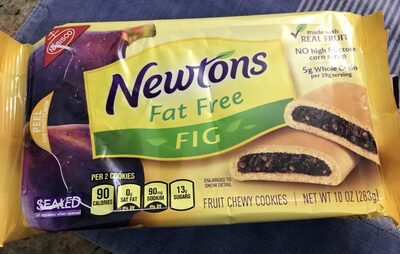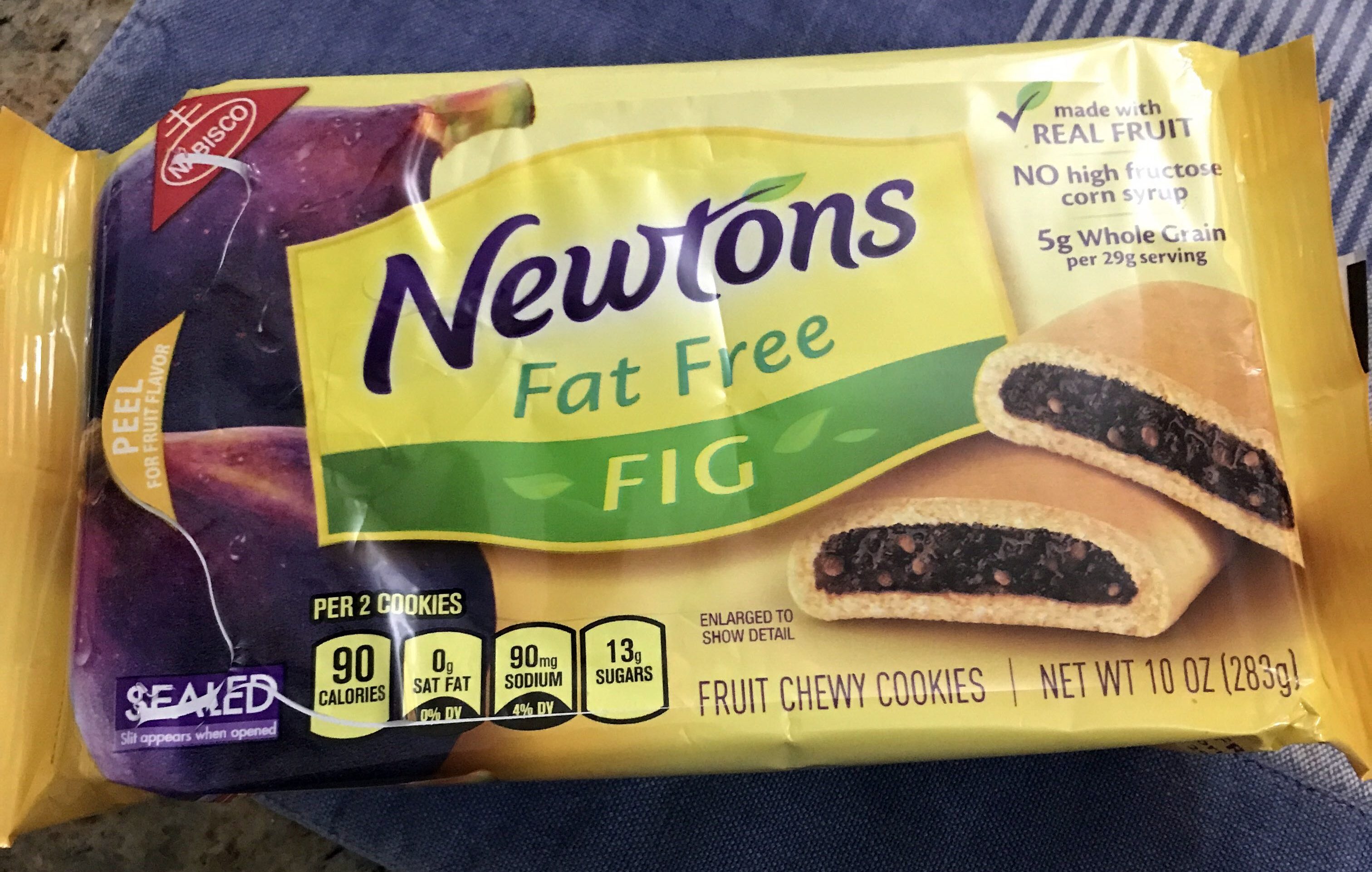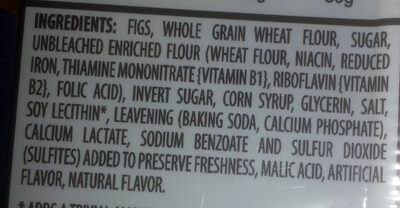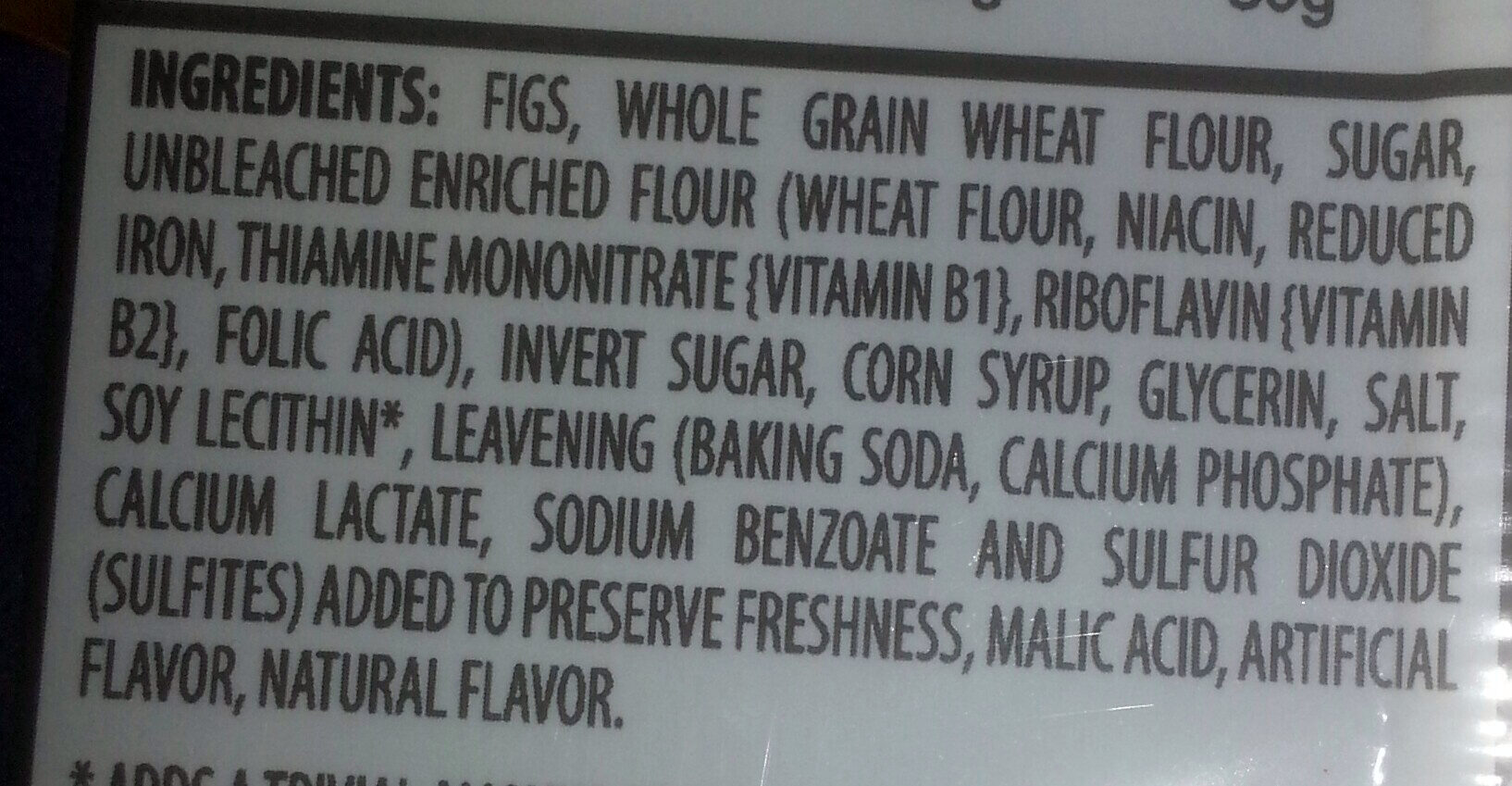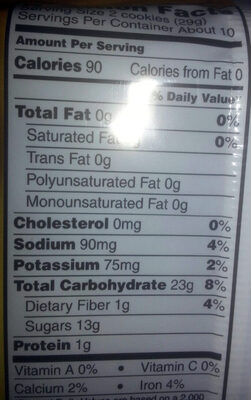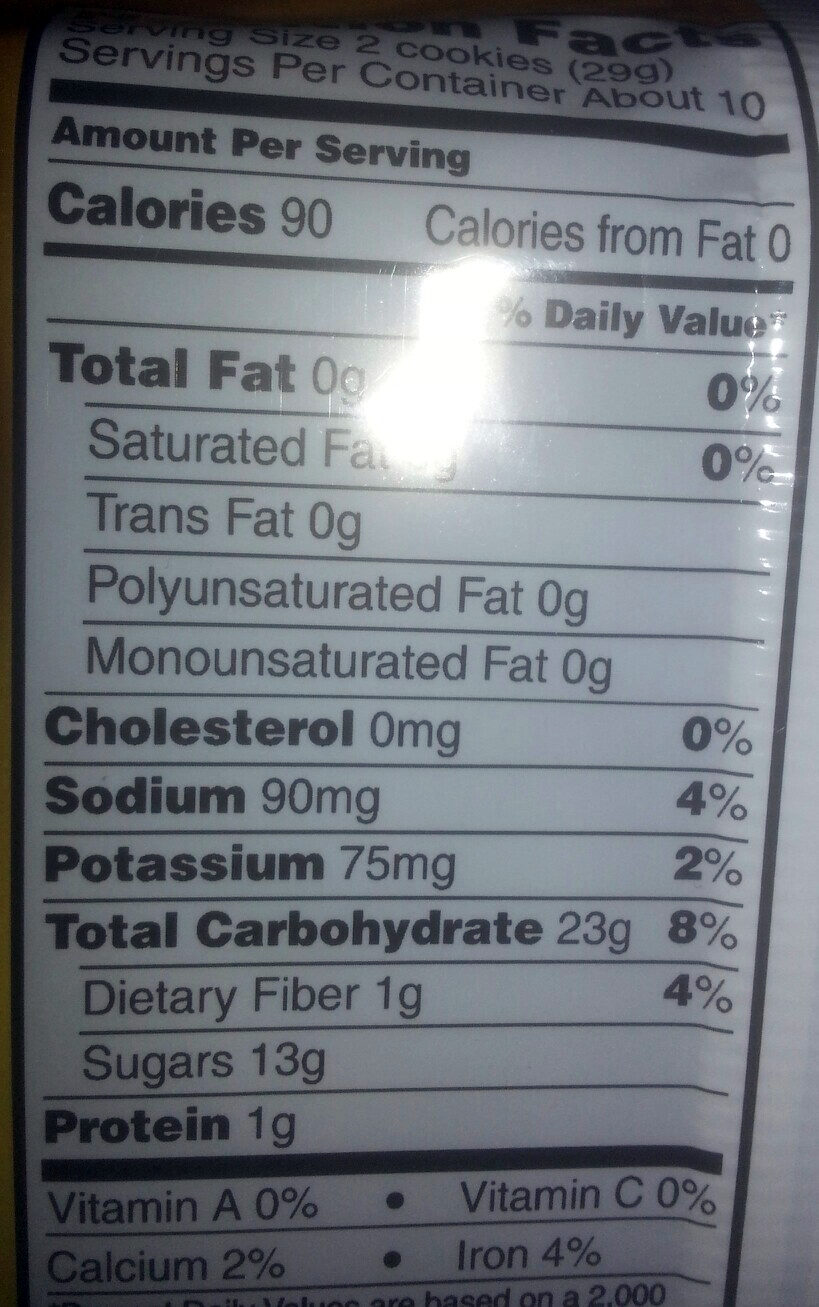Help us make food transparency the norm!
As a non-profit organization, we depend on your donations to continue informing consumers around the world about what they eat.
The food revolution starts with you!
Newtons FIG - 10 oz (283 g)
Newtons FIG - 10 oz (283 g)
This product page is not complete. You can help to complete it by editing it and adding more data from the photos we have, or by taking more photos using the app for Android or iPhone/iPad. Thank you!
×
Barcode: 0044000046521 (EAN / EAN-13) 044000046521 (UPC / UPC-A)
Common name: fruit chewy cookies.
Quantity: 10 oz (283 g)
Brand owner: Mondelez Int. US (0074819091009)
Categories: Snacks, Sweet snacks, Biscuits and cakes, Biscuits, Filled biscuits
Labels, certifications, awards: No HFCS
Origin of ingredients: United States
Manufacturing or processing places: Hanover, New Jersey, Estados Unidos
Traceability code: 040503190014
Link to the product page on the official site of the producer: https://www.mondelezinternational.com/
Countries where sold: Bolivia, Costa Rica, United States
Matching with your preferences
Health
Ingredients
-
26 ingredients
FIGS, WHOLE GRAIN WHEAT FLOUR, SUGAR, UNBLEACHED ENRICHED FLOUR (WHEAT FLOUR, NIACIN, REDUCED IRON, THIAMINE MONONITRATE (VITAMIN B1), RIBOFLAVIN (VITAMIN B2), FOLIC ACID), INVERT SUGAR, CORN SYRUP, GLYCERIN, SALT, SOY LECITHIN, LEAVENING (BAKING SODA, CALCIUM PHOSPHATE), CALCIUM LACTATE, SODIUM BENZOATE, SULFUR DIOXIDE, MALIC ACID, ARTIFICIAL FLAVOR, NATURAL FLAVOR.Allergens: Gluten, Soybeans, Sulphur dioxide and sulphites
Food processing
-
Ultra processed foods
Elements that indicate the product is in the 4 - Ultra processed food and drink products group:
- Additive: E322 - Lecithins
- Additive: E327 - Calcium lactate
- Additive: E422 - Glycerol
- Ingredient: Flavouring
- Ingredient: Invert sugar
Food products are classified into 4 groups according to their degree of processing:
- Unprocessed or minimally processed foods
- Processed culinary ingredients
- Processed foods
- Ultra processed foods
The determination of the group is based on the category of the product and on the ingredients it contains.
Additives
-
E211 - Sodium benzoate
Sodium benzoate: Sodium benzoate is a substance which has the chemical formula NaC7H5O2. It is a widely used food preservative, with an E number of E211. It is the sodium salt of benzoic acid and exists in this form when dissolved in water. It can be produced by reacting sodium hydroxide with benzoic acid.Source: Wikipedia
-
E220 - Sulphur dioxide
Sulfur dioxide: Sulfur dioxide -also sulphur dioxide in British English- is the chemical compound with the formula SO2. It is a toxic gas with a burnt match smell. It is released naturally by volcanic activity and is produced as a by-product of the burning of fossil fuels contaminated with sulfur compounds.Source: Wikipedia
-
E296 - Malic acid
Malic acid: Malic acid is an organic compound with the molecular formula C4H6O5. It is a dicarboxylic acid that is made by all living organisms, contributes to the pleasantly sour taste of fruits, and is used as a food additive. Malic acid has two stereoisomeric forms -L- and D-enantiomers-, though only the L-isomer exists naturally. The salts and esters of malic acid are known as malates. The malate anion is an intermediate in the citric acid cycle.Source: Wikipedia
-
E322 - Lecithins
Lecithins are natural compounds commonly used in the food industry as emulsifiers and stabilizers.
Extracted from sources like soybeans and eggs, lecithins consist of phospholipids that enhance the mixing of oil and water, ensuring smooth textures in various products like chocolates, dressings, and baked goods.
They do not present any known health risks.
-
E322i - Lecithin
Lecithins are natural compounds commonly used in the food industry as emulsifiers and stabilizers.
Extracted from sources like soybeans and eggs, lecithins consist of phospholipids that enhance the mixing of oil and water, ensuring smooth textures in various products like chocolates, dressings, and baked goods.
They do not present any known health risks.
-
E327 - Calcium lactate
Calcium lactate: Calcium lactate is a white crystalline salt with formula C6H10CaO6, consisting of two lactate anions H3C-CHOH-CO−2 for each calcium cation Ca2+. It forms several hydrates, the most common being the pentahydrate C6H10CaO6·5H2O. Calcium lactate is used in medicine, mainly to treat calcium deficiencies; and as a food additive with E number of E327. Some cheese crystals consist of calcium lactate.Source: Wikipedia
-
E341 - Calcium phosphates
Calcium phosphate: Calcium phosphate is a family of materials and minerals containing calcium ions -Ca2+- together with inorganic phosphate anions. Some so-called calcium phosphates contain oxide and hydroxide as well. They are white solids of nutritious value.Source: Wikipedia
-
E422 - Glycerol
Glycerol: Glycerol -; also called glycerine or glycerin; see spelling differences- is a simple polyol compound. It is a colorless, odorless, viscous liquid that is sweet-tasting and non-toxic. The glycerol backbone is found in all lipids known as triglycerides. It is widely used in the food industry as a sweetener and humectant and in pharmaceutical formulations. Glycerol has three hydroxyl groups that are responsible for its solubility in water and its hygroscopic nature.Source: Wikipedia
-
E500 - Sodium carbonates
Sodium carbonates (E500) are compounds commonly used in food preparation as leavening agents, helping baked goods rise by releasing carbon dioxide when they interact with acids.
Often found in baking soda, they regulate the pH of food, preventing it from becoming too acidic or too alkaline. In the culinary world, sodium carbonates can also enhance the texture and structure of foods, such as noodles, by modifying the gluten network.
Generally recognized as safe, sodium carbonates are non-toxic when consumed in typical amounts found in food.
-
E500ii - Sodium hydrogen carbonate
Sodium hydrogen carbonate, also known as E500ii, is a food additive commonly used as a leavening agent.
When added to recipes, it releases carbon dioxide gas upon exposure to heat or acids, causing dough to rise and resulting in a light, fluffy texture in baked goods.
It is generally recognized as safe (GRAS) by regulatory authorities when used in appropriate quantities and poses no significant health risks when consumed in typical food applications.
Ingredients analysis
-
Palm oil free
No ingredients containing palm oil detected
-
Vegan status unknown
Unrecognized ingredients: Reduced iron, Thiamin mononitrate, Thiamin, Folic acid, Invert sugar
-
Vegetarian status unknown
Unrecognized ingredients: Reduced iron, Thiamin mononitrate, Thiamin, Folic acid, Invert sugar
-
Details of the analysis of the ingredients
: FIGS, WHOLE GRAIN WHEAT FLOUR, SUGAR, FLOUR (WHEAT FLOUR, NIACIN, REDUCED IRON, THIAMINE MONONITRATE (VITAMIN B1), RIBOFLAVIN (VITAMIN B2), FOLIC ACID), INVERT SUGAR, CORN SYRUP, GLYCERIN, SALT, SOY LECITHIN, LEAVENING (BAKING SODA, CALCIUM PHOSPHATE), CALCIUM LACTATE, SODIUM BENZOATE, SULFUR DIOXIDE, MALIC ACID, ARTIFICIAL FLAVOR, NATURAL FLAVOR- FIGS -> en:fig - vegan: yes - vegetarian: yes - ciqual_food_code: 13012 - percent_min: 6.25 - percent_max: 100
- WHOLE GRAIN WHEAT FLOUR -> en:whole-wheat-flour - vegan: yes - vegetarian: yes - ciqual_proxy_food_code: 9410 - percent_min: 0 - percent_max: 50
- SUGAR -> en:sugar - vegan: yes - vegetarian: yes - ciqual_proxy_food_code: 31016 - percent_min: 0 - percent_max: 33.3333333333333
- FLOUR -> en:flour - vegan: yes - vegetarian: yes - ciqual_proxy_food_code: 9410 - percent_min: 0 - percent_max: 25
- WHEAT FLOUR -> en:wheat-flour - vegan: yes - vegetarian: yes - ciqual_proxy_food_code: 9410 - percent_min: 0 - percent_max: 25
- NIACIN -> en:e375 - vegan: maybe - vegetarian: maybe - percent_min: 0 - percent_max: 12.5
- REDUCED IRON -> en:reduced-iron - percent_min: 0 - percent_max: 8.33333333333333
- THIAMINE MONONITRATE -> en:thiamin-mononitrate - percent_min: 0 - percent_max: 6.25
- VITAMIN B1 -> en:thiamin - percent_min: 0 - percent_max: 6.25
- RIBOFLAVIN -> en:e101 - vegan: maybe - vegetarian: yes - percent_min: 0 - percent_max: 5
- VITAMIN B2 -> en:e101 - vegan: maybe - vegetarian: yes - percent_min: 0 - percent_max: 5
- FOLIC ACID -> en:folic-acid - percent_min: 0 - percent_max: 4.16666666666667
- INVERT SUGAR -> en:invert-sugar - percent_min: 0 - percent_max: 20
- CORN SYRUP -> en:corn-syrup - vegan: yes - vegetarian: yes - ciqual_proxy_food_code: 31089 - percent_min: 0 - percent_max: 16.6666666666667
- GLYCERIN -> en:e422 - vegan: maybe - vegetarian: maybe - percent_min: 0 - percent_max: 14.2857142857143
- SALT -> en:salt - vegan: yes - vegetarian: yes - ciqual_food_code: 11058 - percent_min: 0 - percent_max: 0.776
- SOY LECITHIN -> en:soya-lecithin - vegan: yes - vegetarian: yes - ciqual_food_code: 42200 - percent_min: 0 - percent_max: 0.776
- LEAVENING -> en:raising-agent - percent_min: 0 - percent_max: 0.776
- BAKING SODA -> en:e500ii - vegan: yes - vegetarian: yes - percent_min: 0 - percent_max: 0.776
- CALCIUM PHOSPHATE -> en:e341 - vegan: yes - vegetarian: yes - percent_min: 0 - percent_max: 0.388
- CALCIUM LACTATE -> en:e327 - vegan: yes - vegetarian: yes - percent_min: 0 - percent_max: 0.776
- SODIUM BENZOATE -> en:e211 - vegan: yes - vegetarian: yes - percent_min: 0 - percent_max: 0.776
- SULFUR DIOXIDE -> en:e220 - vegan: yes - vegetarian: yes - percent_min: 0 - percent_max: 0.776
- MALIC ACID -> en:e296 - vegan: yes - vegetarian: yes - percent_min: 0 - percent_max: 0.776
- ARTIFICIAL FLAVOR -> en:artificial-flavouring - vegan: maybe - vegetarian: maybe - percent_min: 0 - percent_max: 0.776
- NATURAL FLAVOR -> en:natural-flavouring - vegan: maybe - vegetarian: maybe - percent_min: 0 - percent_max: 0.776
Nutrition
-
Poor nutritional quality
⚠ ️Warning: the amount of fruits, vegetables and nuts is not specified on the label, it was estimated from the list of ingredients: 53This product is not considered a beverage for the calculation of the Nutri-Score.
Positive points: 4
- Proteins: 2 / 5 (value: 3.45, rounded value: 3.45)
- Fiber: 3 / 5 (value: 3.45, rounded value: 3.45)
- Fruits, vegetables, nuts, and colza/walnut/olive oils: 1 / 5 (value: 53.125, rounded value: 53.1)
Negative points: 15
- Energy: 3 / 10 (value: 1300, rounded value: 1300)
- Sugars: 9 / 10 (value: 44.8, rounded value: 44.8)
- Saturated fat: 0 / 10 (value: 0, rounded value: 0)
- Sodium: 3 / 10 (value: 310, rounded value: 310)
The points for proteins are not counted because the negative points are greater or equal to 11.
Nutritional score: (15 - 4)
Nutri-Score:
-
Nutrient levels
-
Fat in low quantity (0%)
What you need to know- A high consumption of fat, especially saturated fats, can raise cholesterol, which increases the risk of heart diseases.
Recommendation: Limit the consumption of fat and saturated fat- Choose products with lower fat and saturated fat content.
-
Saturated fat in low quantity (0%)
What you need to know- A high consumption of fat, especially saturated fats, can raise cholesterol, which increases the risk of heart diseases.
Recommendation: Limit the consumption of fat and saturated fat- Choose products with lower fat and saturated fat content.
-
Sugars in high quantity (44.8%)
What you need to know- A high consumption of sugar can cause weight gain and tooth decay. It also augments the risk of type 2 diabetes and cardio-vascular diseases.
Recommendation: Limit the consumption of sugar and sugary drinks- Sugary drinks (such as sodas, fruit beverages, and fruit juices and nectars) should be limited as much as possible (no more than 1 glass a day).
- Choose products with lower sugar content and reduce the consumption of products with added sugars.
-
Salt in moderate quantity (0.776%)
What you need to know- A high consumption of salt (or sodium) can cause raised blood pressure, which can increase the risk of heart disease and stroke.
- Many people who have high blood pressure do not know it, as there are often no symptoms.
- Most people consume too much salt (on average 9 to 12 grams per day), around twice the recommended maximum level of intake.
Recommendation: Limit the consumption of salt and salted food- Reduce the quantity of salt used when cooking, and don't salt again at the table.
- Limit the consumption of salty snacks and choose products with lower salt content.
-
-
Nutrition facts
Nutrition facts As sold
for 100 g / 100 mlAs sold
per serving (2 cookies 29 g)Compared to: Filled biscuits Energy 1,300 kj
(310 kcal)377 kj
(90 kcal)-34% Fat 0 g 0 g -100% Saturated fat 0 g 0 g -100% Trans fat 0 g 0 g -100% Cholesterol 0 mg 0 mg -100% Carbohydrates 79.3 g 23 g +19% Sugars 44.8 g 13 g +35% Added sugars 31 g 9 g -15% Fiber < 3.45 g < 1 g +19% Proteins 3.45 g 1 g -39% Salt 0.776 g 0.225 g +42% Vitamin A 0 µg 0 µg (0 % DV) Vitamin C (ascorbic acid) 0 mg 0 mg (0 % DV) -100% Potassium 276 mg 80 mg +93% Calcium 69 mg 20 mg (2 % DV) +6% Iron 2.48 mg 0.72 mg (4 % DV) -30% Fruits‚ vegetables‚ nuts and rapeseed‚ walnut and olive oils (estimate from ingredients list analysis) 53.125 % 53.125 %
Environment
-
Eco-Score B - Low environmental impact
⚠ ️Select a country in order to include the full impact of transportation.The Eco-Score is an experimental score that summarizes the environmental impacts of food products.→ The Eco-Score was initially developped for France and it is being extended to other European countries. The Eco-Score formula is subject to change as it is regularly improved to make it more precise and better suited to each country.Life cycle analysis
-
Average impact of products of the same category: B (Score: 69/100)
Category: Biscuit (cookie)
Category: Biscuit (cookie)
- PEF environmental score: 0.35 (the lower the score, the lower the impact)
- including impact on climate change: 2.88 kg CO2 eq/kg of product
Stage Impact Agriculture
80.5 %Processing
11.8 %Packaging
3.1 %Transportation
3.2 %Distribution
1.4 %Consumption
0.0 %
Bonuses and maluses
-
Origins of ingredients with a medium impact
Bonus: +1
Environmental policy: +1
Transportation: 0
Origin of the product and/or its ingredients % of ingredients Impact United States 100 %Medium
-
Packaging with a medium impact
Malus: -10
Shape Material Recycling Impact 1 Bag Plastic High
Eco-Score for this product
-
Impact for this product: B (Score: 60/100)
Product: Newtons FIG - 10 oz (283 g)
Life cycle analysis score: 69
Sum of bonuses and maluses: -9
Final score: 60/100
-
Carbon footprint
-
Equal to driving 1.5 km in a petrol car
288 g CO² per 100g of product
The carbon emission figure comes from ADEME's Agribalyse database, for the category: Biscuit (cookie) (Source: ADEME Agribalyse Database)
Stage Impact Agriculture
82.9 %Processing
7.9 %Packaging
3.8 %Transportation
4.7 %Distribution
0.7 %Consumption
0.0 %
Packaging
-
Packaging with a medium impact
-
Packaging parts
1 x Bag (Plastic)
-
Packaging materials
Material % Packaging weight Packaging weight per 100 g of product Plastic
-
Transportation
-
Origins of ingredients
Origins of ingredients with a medium impact
Origin of the product and/or its ingredients % of ingredients Impact United States 100 %Medium
Report a problem
-
Incomplete or incorrect information?
Category, labels, ingredients, allergens, nutritional information, photos etc.
If the information does not match the information on the packaging, please complete or correct it. Open Food Facts is a collaborative database, and every contribution is useful for all.
Data sources
Product added on by openfoodfacts-contributors
Last edit of product page on by 5m4u9.
Product page also edited by ecoscore-impact-estimator, kiliweb, org-database-usda, roboto-app, teolemon, yuka.sY2b0xO6T85zoF3NwEKvllFVcMTjqBmZbQTnhXSKzI3SCr7vQepAzq7XF6s.
